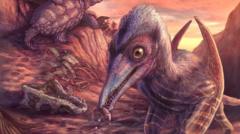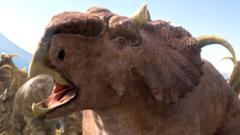A recent study reveals that a large terror bird, estimated to stand over 2.5 meters tall, likely fell victim to an even larger caiman 13 million years ago in what is now Colombia's Tatacoa Desert. The findings, based on teeth marks found on the fossilized leg bone, illuminate the complex dynamics of ancient predator interactions.
Fossil Evidence Reveals Clash Between Terror Bird and Caiman 13 Million Years Ago

Fossil Evidence Reveals Clash Between Terror Bird and Caiman 13 Million Years Ago
Paleontologists uncover evidence of a fierce battle between a terror bird and a colossal caiman, suggesting an unexpected vulnerability among apex predators.
The bones of a terror bird, a formidable predator that roamed the Earth 13 million years ago, have unveiled a dramatic narrative of survival and death. Researchers in Colombia have discovered teeth marks on the leg bone of this avian reptile, indicating it was possibly killed by an even larger predator—a caiman, or a crocodilian. This significant paleontological find sheds light on the often brutal interactions between apex predators of the era and challenges previous notions about their vulnerability.
The newly published study in the journal Biology Letters involved a meticulous examination of the fossilized leg bone originally unearthed over 15 years ago in the Tatacoa Desert. The researchers utilized 3D digital scans to compare the distinctive bites with existing museum specimens of related crocodilian species, identifying the culprit behind the bloodshed—Purussaurus neivensis, a gigantic caiman that could reach lengths of up to five meters.
The dramatic interactions between predator and prey are underscored by the lack of healing observed in the bite marks, suggesting the terror bird did not survive the encounter. Lead researcher Andres Link, associated with the Universidad de Los Andes in Bogotá, expressed the weight of this discovery: "That was the last day that bird was on this planet—then a piece of its leg bone was found 13 million years later."
The leg bone’s origin leads back to the humid swamps typical of the Middle Miocene epoch, where the silt and sediment trapped and preserved extraordinary fossil remains. It was through collaboration with local collector César Augusto Perdomo that this bone was identified as belonging to a terror bird, a category of fossil known for its distinctive features, yet rarely found.
Dr. Link remarks on the significance of such findings, pointing out that even the tiniest pieces of evidence deepen our understanding of historical ecosystems. The implications of a terror bird's vulnerability highlight the nuanced nature of predatory dynamics in prehistoric environments, leaving us to ponder the perils faced by these once-dominant species.
In uncovering this ancient tale of nature's struggle, the findings serve not only to inform our understanding of prehistoric life but also illustrate how inter-species rivalry shaped the ecosystems of their time. As researchers continue to study and categorize these rich fossil deposits, further insights into the prehistoric past await discovery.

















